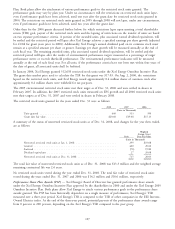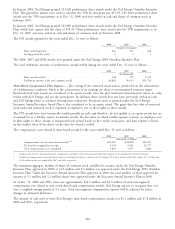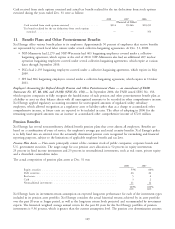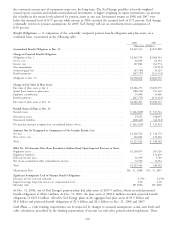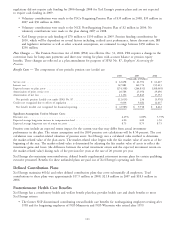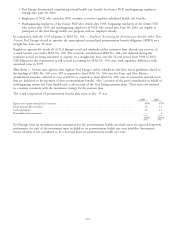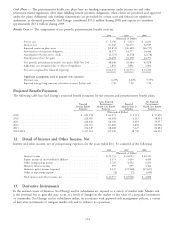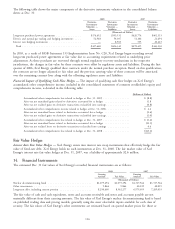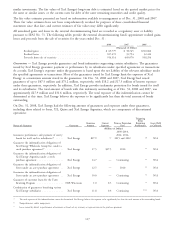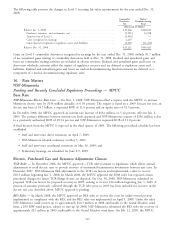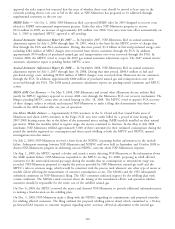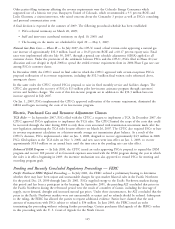Xcel Energy 2008 Annual Report Download - page 125
Download and view the complete annual report
Please find page 125 of the 2008 Xcel Energy annual report below. You can navigate through the pages in the report by either clicking on the pages listed below, or by using the keyword search tool below to find specific information within the annual report.Commodity Price Risk — Xcel Energy’s utility subsidiaries are exposed to commodity price risk in their electric and
natural gas operations. Commodity price risk is managed by entering into long- and short-term physical purchase and
sales contracts for electric capacity, energy and energy-related products and for various fuels used in generation and
distribution activities. Commodity risk is also managed through the use of financial derivative instruments. Xcel
Energy’s utility subsidiaries utilize these derivative instruments to reduce the volatility in the cost of commodities
acquired on behalf of its retail customers even though regulatory jurisdiction may provide for recovery of actual costs.
Xcel Energy’s risk-management policy allows it to manage commodity price risk within each rate-regulated operation to
the extent such exposure exists.
Short-Term Wholesale and Commodity Trading Risk — Xcel Energy’s utility subsidiaries conduct various short-term
wholesale and commodity trading activities, including the purchase and sale of electric capacity, energy and energy-
related instruments. Xcel Energy’s risk-management policy allows management to conduct these activities within
guidelines and limitations as approved by the risk-management committee, which is made up of management personnel
not directly involved in the activities governed by this policy.
Interest Rate Risk — Xcel Energy and its subsidiaries are subject to the risk of fluctuating interest rates in the normal
course of business. Xcel Energy’s risk-management policy allows interest rate risk to be managed through the use of
fixed-rate debt, floating-rate debt and interest rate derivatives such as swaps, caps, collars and put or call options.
Types of and Accounting for Derivative Instruments
Xcel Energy and its subsidiaries use derivative instruments in connection with its interest rate, utility commodity price,
vehicle fuel price, short-term wholesale and commodity trading activities, including forward contracts, futures, swaps
and options. All derivative instruments not designated and qualifying for the normal purchases and normal sales
exception, as defined by SFAS No. 133, are recorded on the consolidated balance sheets at fair value as derivative
instruments valuation. This includes certain instruments used to mitigate market risk for the utility operations and all
instruments related to the commodity trading operations. The classification of changes in fair value for those derivative
instruments is dependent on the designation of a qualifying hedging relationship. Changes in fair value of derivative
instruments not designated in a qualifying hedging relationship are reflected in current earnings or as a regulatory asset
or liability. The classification is dependent on the applicability of specific regulation.
Qualifying hedging relationships are designated as either a hedge of a forecasted transaction or future cash flow (cash
flow hedge), or a hedge of a recognized asset, liability or firm commitment (fair value hedge). The types of qualifying
hedging transactions that Xcel Energy and its subsidiaries are currently engaged in are discussed below.
Cash Flow Hedges
Commodity Cash Flow Hedges — Xcel Energy’s utility subsidiaries enter into derivative instruments to manage
variability of future cash flows from changes in commodity prices. This could include the purchase or sale of energy or
energy-related products, natural gas to generate electric energy, gas for resale, and vehicle fuel. Certain derivative
instruments entered into to manage this variability are designated as cash flow hedges for accounting purposes. At
Dec. 31, 2008, Xcel Energy had various commodity-related contracts classified as cash flow hedges extending through
December 2010. Changes in the fair value of cash flow hedges are recorded in other comprehensive income or deferred
as a regulatory asset or liability. This classification is based on the regulatory recovery mechanisms in place.
At Dec. 31, 2008, Xcel Energy had $11.6 million of net losses in accumulated other comprehensive income related to
commodity cash flow hedge contracts; $6.8 million is expected to be recognized in earnings during the next 12 months
as the hedged transactions settle.
Xcel Energy had immaterial ineffectiveness related to commodity cash flow hedges during 2008 and 2007.
Interest Rate Cash Flow Hedges — Xcel Energy and its subsidiaries enter into various instruments that effectively fix the
interest payments on certain floating rate debt obligations or effectively fix the yield or price on a specified benchmark
interest rate for a specific period. These derivative instruments are designated as cash flow hedges for accounting
purposes.
At Dec. 31, 2008, Xcel Energy had $0.7 million of net losses in accumulated other comprehensive income related to
interest rate hedges that are expected to be recognized in earnings during the next 12 months.
Xcel Energy had immaterial ineffectiveness related to interest rate cash flow hedges during 2008 and 2007.
115




